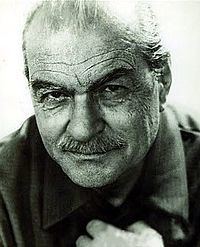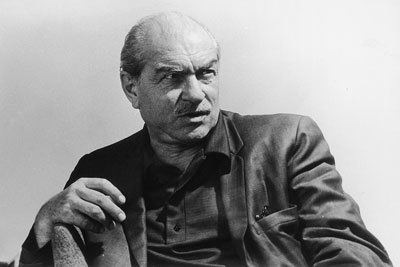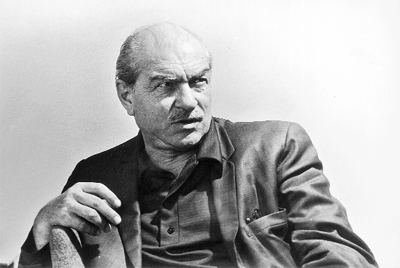Name Kemal Tahir | Role Novelist Parents Tahir Bey, Nuriye Hanim | |
 | ||
Movies Haremde Dort Kadin, Tomorrow Is Ours Spouse Semiha Sidika Hanim (m. 1950–1973), Fatma Irfan (m. 1937) Books Esir Sehrin Insanlari, Yorgun Savasci, Yol Ayrimi, Koyun Kamburu, Devlet Ana Similar People Orhan Kemal, Yasar Kemal, Halit Refig, Nazim Hikmet, Atif Yilmaz | ||
Kemal tahir
Kemal Tahir (March 13, 1910 - April 21, 1973) was a prominent Turkish novelist and intellectual. Tahir spent 13 years of his life imprisoned due to political reasons and wrote some of his most important novels during this time.
Contents

His most important novels include Esir Şehrin İnsanları (1956), Devlet Ana (1967) and Yorgun Savaşçı (1965), all in which Tahir uses historical background to support his characters and settings. Some of his novels were adapted into popular films. Tahir also wrote pulp fiction under pseudonyms for financial reasons.

Kemal Tahir
Biography

Kemal Tahir was born on March 13, 1910. His father Tahir Bey was a navy captain and an adviser to Sultan Abdulhamit II. After graduating from Hasan Paşa Rüşdiyesi (secondary school), Kemal Tahir enrolled to Galatasaray High School. But after his mother's death, he dropped out high school at 10th grade and began working as a lawyer's clerk, and later as a journalist. He worked as a journalist, editor and a translator at Vakit, Haber and Son Posta newspapers in İstanbul. He worked as a page editor at Karikatür and Yeni Gün newspapers. He became lead writer for the newspaper Karagöz and later worked as the editor-in-chief at Tan. He married Fatma İrfan in 1937.

In 1938, Kemal Tahir and Nazım Hikmet was accused of "spreading sedition" amongst the armed forces by the Navy Command Court Martial, was subsequently found guilty and sentenced to 15 years in prison. He served time in Çankırı, Malatya, Çorum, Nevşehir and Kırşehir prisons. Twelve years later, he was released in the general amnesty of 1950.
Following his release, Kemal Tahir returned to Istanbul and started working as Istanbul correspondent of The Izmir Commerce newspaper. He married his second wife Semiha Sıdıka. He wrote romance and adventure novels and film scripts, using aliases such as "Körduman", "Bedri Eser", "Samim Aşkın", "f. m. ikinci", "Nurettin Demir", or "Ali Gıcırlı". He also undertook translations from French. He was taken into custody again following the 6–7 September incidents in 1955 and served six months in the Harbiye military prison. Upon his release he ran Düşün Publishing, which he co-founded with the writer Aziz Nesin.
He worked on film scripts with directors such as Metin Erksan, Halit Refiğ and Atıf Yılmaz.
He travelled to the USSR in 1968.
After having a lung operation in 1970, Tahir worked on vernacularizing Marxist terminology and creating a national left ideology, which would suit a Turkish-Anatolian socio-cultural identity. In doing so, he was criticized by many left wing intellectuals. During a particularly heated debate, Kemal Tahir suffered a heart attack and died on April 21, 1973.
Ideology
The foundation of Kemal Tahir's ideology can be broadly described as Marxist. As a writer and a political activist, he saw a contradiction between the socio-cultural and political structure of Turkey and solutions that Marxism offers. Due to his belief that Westernization was something that did not quite fit Turkish society, he found Marxism somewhat lacking. Marxist historical theory is based on the existence of a bourgeois class, something that did not develop in the Ottoman Empire (as in many other 'peripheral countries'). Perhaps the greatest intellectual struggle of Tahir's was in reshaping Marxist historical theory to the reality of Turkish history.
After studying Marx and Engels' opinions about eastern societies, Kemal Tahir worked on historical theories of historians and sociologists like Ömer Lütfi Barkan, Mustafa Akdağ, Halil İnalcık, Niyazi Berkes and Şerif Mardin. His conclusion was that Ottoman-Turkish society does not follow euro-centric primitive/slavery/feodality/capitalism socio-historical model. It has its own special evolution process, structural differences, dynamics and conditions based on its cultural and social structure. So Westernization, whether in form of capitalism or communism, is trying to bring an abstract and formal superstructure to a society which does not have the necessary substructure. Without a fundamental economic and social revolution this kind of exercises would be nothing but an absurd mimicry.
In frame of this ideology, Kemal Tahir aimed to describe the Ottoman society in his works which was based on a humanist foundation which was very different from European feudal and later capitalist society. He tried to emphasize a "Turkish reality" in his novels.
In his writing career, which was in socio-realist line, he used a simple language that was enriched with dialogues and charismatic characters. He was one of the most productive novelists of Turkish literature.
Works
Kemal Tahir started to literature with poetry. His first poems were published in İçtihad magazine in 1931. He got published poems in Yeni Kültür, Geçit, Var and Ses magazines.
His first major work was a four-part novella that was published at Tan newspaper and later published as a book in 1955, titled Göl İnsanları (People of The Lake). Again in 1955, he became well-known with his novel Sağırdere (Deaf River).
Esir Şehrin İnsanları (People of the Captive City), first of his city novels that he took İstanbul as a frame to observe Turks' transition from Ottoman Empire to the Republic, was published in 1956. İn this novel, Tahir described İstanbul under occupation after the World War I. Sequels to this novel, Esir Şehrin Mahpusu (Prisoner of the Captive City) was published in 1961 and Yol Ayrımı (Parting of the Ways) in 1971.
At first, Kemal Tahir focused on problems of peasants. Then, he dealt with Turkish history, especially events of recent history. In his novel Devlet Ana (Mother State) he described governmental and social structure of Ottoman society at its beginnings; in Kurt Kanunu (Law of Wolf), he narrates the Izmir assassination incident, which was a failed attempt to kill Ataturk; he analysed banditry phenomenon in Rahmet Yolları Kesti (Rain Closed the Roads) and "ağa" system in Yedi Çınar Yaylası (Seven Plane Tree Plateau). İn his historical novel Yorgun Savaşçı (Tired Warrior), Tahir narrates the period that the national resistance forces in Anatolia without a leader came together and started the Turkish Independence War.
Because of financial difficulties, Kemal Tahir wrote pulp fiction novels under pseudonyms. He also translated Mike Hammer novels and even wrote original new novels for that series.
Some of his novels (like Karılar Koğuşu, Haremde Dört Kadın, Esir Şehrin İnsanları and Kurt Kanunu) later adapted into movies.
